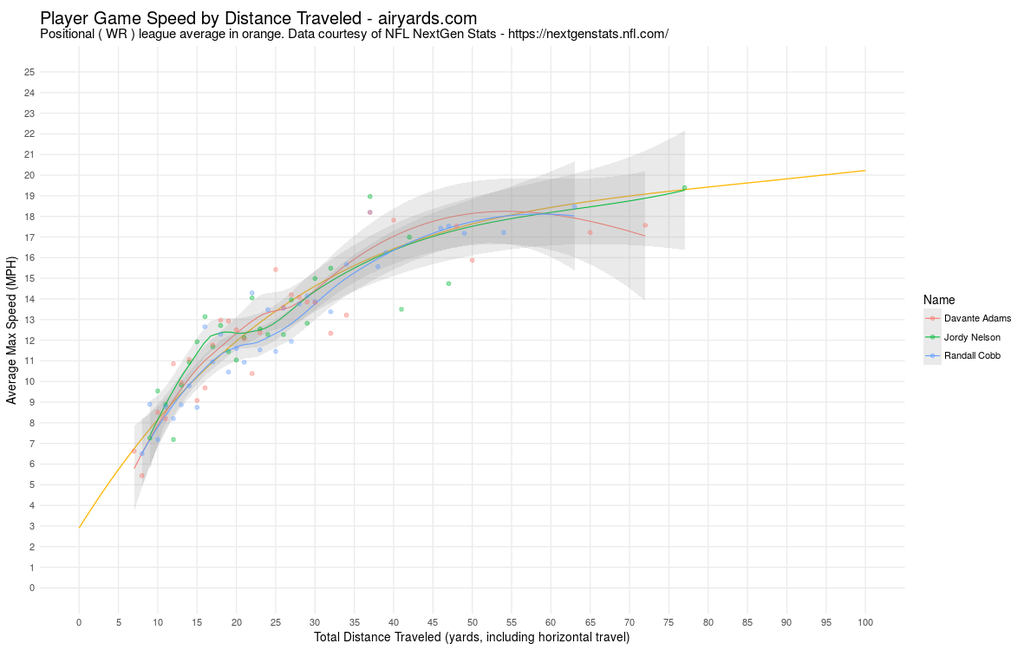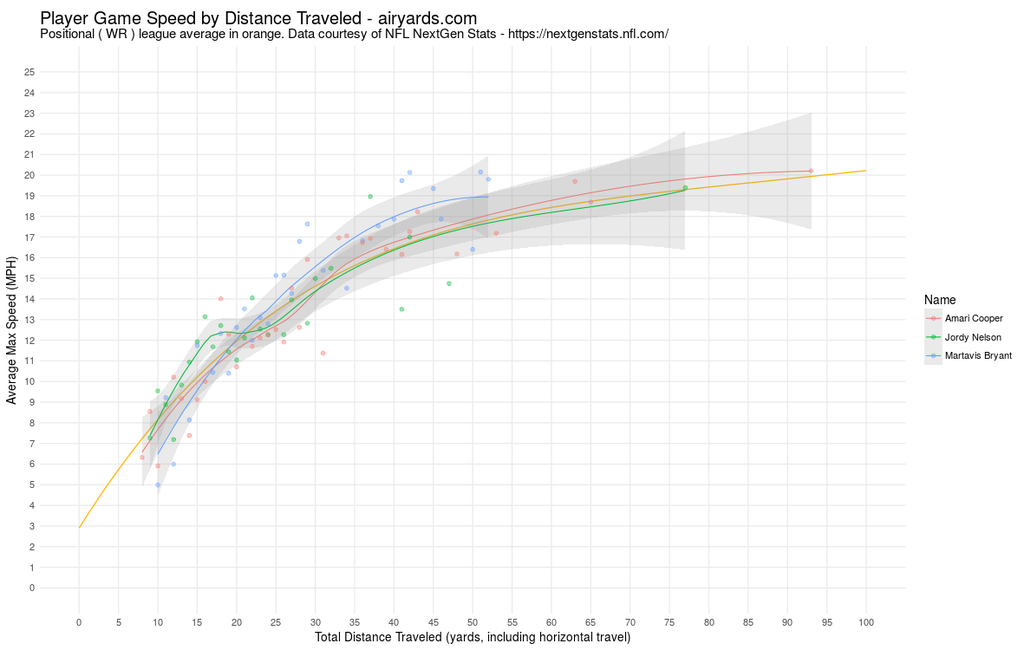Fantasy Football: Jordy Nelson Isn't Done Yet

The 2017 season was not kind to Jordy Nelson.
He missed the Week 2 game against the Atlanta Falcons due to a quadriceps strain, and Aaron Rodgers suffered a fractured clavicle against the Minnesota Vikings early in Week 6. Brett Hundley completed that game and started the next eight contests. With Rodgers out, Nelson's production took a major hit as he failed to eclipse 50 yards receiving or score a touchdown in any game Hundley started. Rodgers did return for Week 15 against the Carolina Panthers, but Nelson was limited to only 3 receptions for 28 yards on 6 targets in that one.
Nelson finished the year with 53 receptions (on 88 targets), 482 yards, and 6 touchdowns for 137.2 PPR points. That was "good" enough for a measly WR48 campaign, his worst fantasy finish since 2012.
In March, the Green Bay Packers cut him, freeing up more than $10 million in cap savings. After 10 years with the Packers, does Nelson have anything left in the tank to help your fantasy team in 2018?
After-Math
Nelson's raw numbers for the 2017 leave a lot to be desired, especially since he was drafted as the WR6 and 12th player overall in 2017 PPR leagues, per Fantasy Football Calculator. But how bad was it?
Digging into our Net Expected Points (NEP) metric, it doesn't paint Nelson in a favorable light. He registered just 0.54 Reception NEP per target, the lowest of his career, compared to 0.58 for Randall Cobb and 0.78 for Davante Adams, who dealt with the exact same situation in Green Bay. Nelson did have an 83.02% Reception Success Rate -- the percentage of catches that resulted in positive NEP -- but he falls below his teammates again with a 60.23% catch rate.
If there's reason for optimism, it's that the drop from Rodgers to Hundley was massive.
| Quarterback | Starts | Passing NEP Per Drop Back |
|---|---|---|
| Rodgers | 7 | 0.13 |
| Hundley | 9 | -0.14 |
The only quarterback with a lower total Passing NEP than Hundley's -48.07 last year was DeShone Kizer (-89.82), who is now competing against Hundley for the backup job in Green Bay.
On a per-attempt basis, Hundley's -0.14 Passing NEP per drop back is within the range of Tom Savage (-0.12) and C.J. Beathard (-0.15) on a similar number of attempts.
In short, Nelson was dealing with horrendous quarterback play sans Rodgers, and that was obviously a key factor in his disappointing fantasy output.
What the FUPA?
At 33 years of age, what can we expect from Nelson athletically? More specifically, as a down-field threat, does Nelson still have the requisite speed to play on the outside compared to other receivers?
To find out, let's utilize Josh Hermsmeyer's airyards.com to view game speed from NFL.com's Next-Gen Stats. Hermsmeyer invented a metric called "Fastness Under/Above Positional Average" (FUPA/FAPA) as well as an app to compare players, which we'll put to use.
The below graph shows Nelson, Adams, and Cobb for the 2017 season. You can sort by play type in the app, and since I'm focusing on wide receivers, only receptions are displayed.
In the graph below, average max speed is shown on the y-axis, and total distance traveled on the x-axis. It's important to note distance traveled also includes horizontal travel, and it does not represent yards gained, though there is little to differentiate the two out to 50 yards.

The orange line represents the aforementioned positional league average for wide receivers. Nelson breaks above the average from 10 to 20 yards. While he falls below it from 20-to-30-yard range, he stays very close to it from 35-yards plus.
Adams starts out well below average and slowly overtakes it around 13 yards traveled and stays ahead out to 25 yards. He, too, briefly falls below the positional average before overtaking it around 33 yards. Like Adams, Cobb also starts below the average and falls in line around 13 yards traveled before falling off quickly just before 20 yards of travel. It takes another 20 yards before Cobb catches up to the positional average max speed.
We can also compare the overall FUPA/FAPA results for 2016 and 2017 between Green Bay's three key receivers to see if Nelson has indeed lost his big-play ability.
| Receiver | 2016 FUPA | 2017 FUPA |
|---|---|---|
| Jordy Nelson | 5.1 | 3.6 |
| Davante Adams | -2.8 | -1.7 |
| Randall Cobb | -15.0 | -5.8 |
Did Jordy slow down from 2016 to 2017? Yes. But the overall change is relatively small, and he was above league average both years. This is even more impressive considering Lambeau Field is the slowest field in the league.
Hangin' With Mr. Cooper
It appears Nelson still has the requisite speed on the field, especially in the intermediate area out to 20 yards. How does that look compared with his new teammates?
Let's removed Adams and Cobb and replace them Amari Cooper and Martavis Bryant, Nelson's new sidekicks. (While there have been some reports that Bryant could could be in line for another suspension, as of now, he's cleared to play.)

It's interesting that Bryant's and Nelson's trajectories cross just past 20 yards traveled, and Bryant stays well above the positional average. Cooper lags behind the average before overtaking it around 33 yards traveled.
On the surface, it appears deploying Nelson in the intermediate area with Bryant deep and Cooper from the slot makes sense based off the speed data from 2017. However, after the season, quarterback Derek Carr said Cooper was dealing with multiple injuries, which could help explain why his FUPA score dropped from 8.2 in 2016 to -3.7 in 2017.
2018 Projection
With Jon Gruden returning to the Raiders and the NFL, much has been made of his comments on "taking the game back to 1998." Given how the NFL rules have changed to benefit offenses in the years since Gruden left for the broadcast booth, it's easy to assume his comments meant he was intending to deploy more of a run-focused approach.
However, in his prior 14 seasons as offensive coordinator or head coach, his offenses have finished in the top-12 for pass attempts seven times, per Pro-Football-Reference. By signing older players, such as Nelson and Doug Martin, it appears those comments were directed more toward personnel than scheme.
For the upcoming season, our models are projecting Derek Carr for 578 pass attempts, the eighth-most among all quarterbacks, and that fits within the context of Gruden's prior history. As for Nelson, we're forecasting him for 84 receptions, 804 yards, and 4 touchdowns -- making him our WR38, just behind Sammy Watkins and ahead of Kelvin Benjamin. Nelson is currently being drafted in that range, going as -- on average -- the WR39 in 12-team PPR drafts, per Fantasy Football Calculator.
While there is certainly a drop in quarterback play from Rodgers to Carr, it shouldn't be as perilous as the massive fall from Rodgers to Hundley. According to player tracking data, Nelson appears to be fighting off Father Time fairly well and will be moving to a faster playing field in Oakland. With Bryant's future possibly uncertain, there is an avenue for additional targets to find their way to Nelson, and combining Gruden's history and our projections should help alleviate passing-volume concerns for the offense.
Nelson is far from done and offers a nice combination of a solid floor and decent ceiling at his current ADP.
















